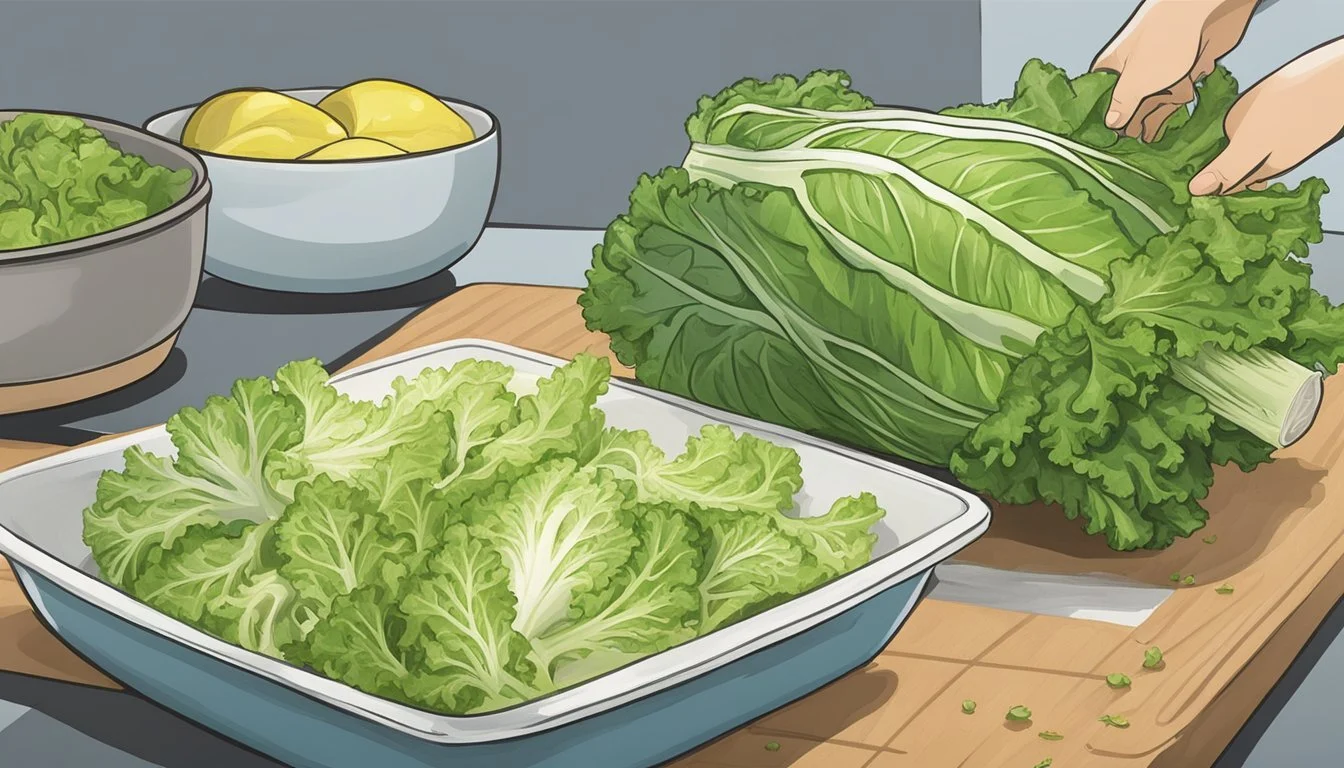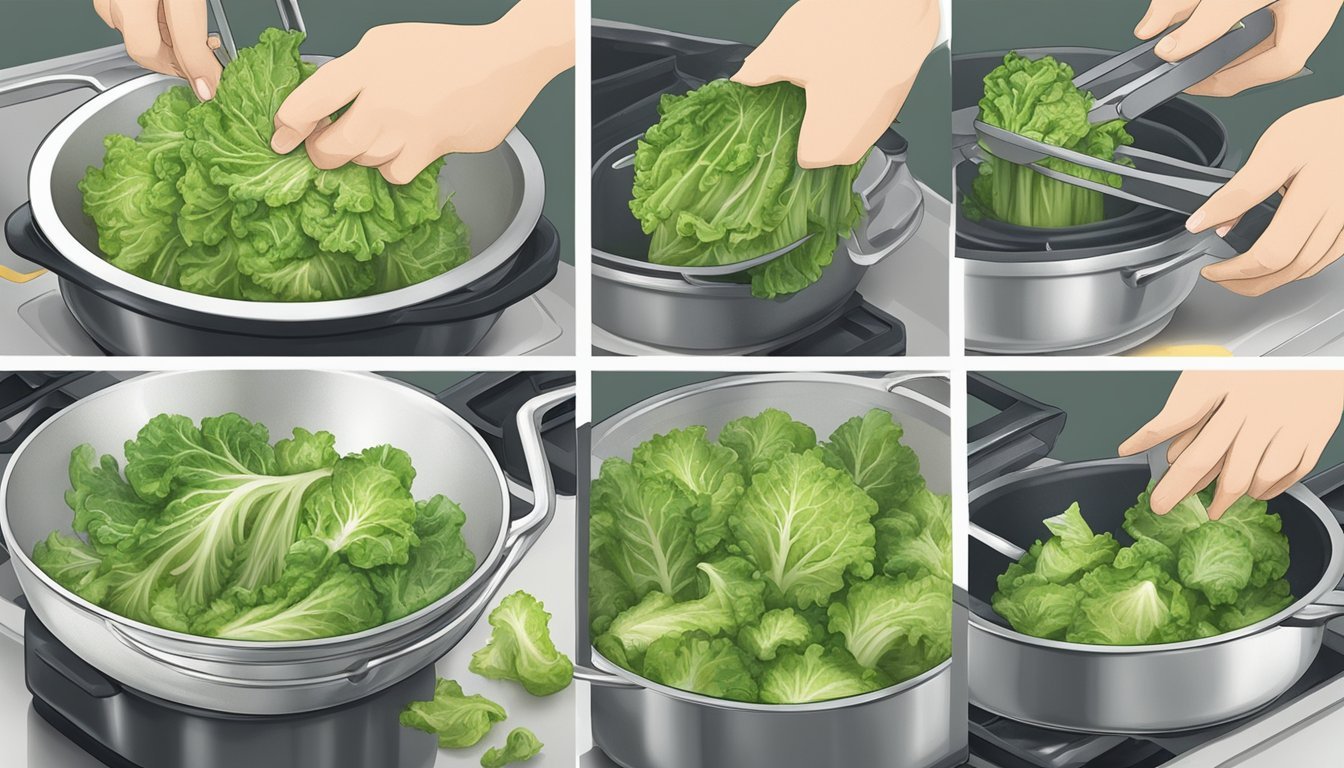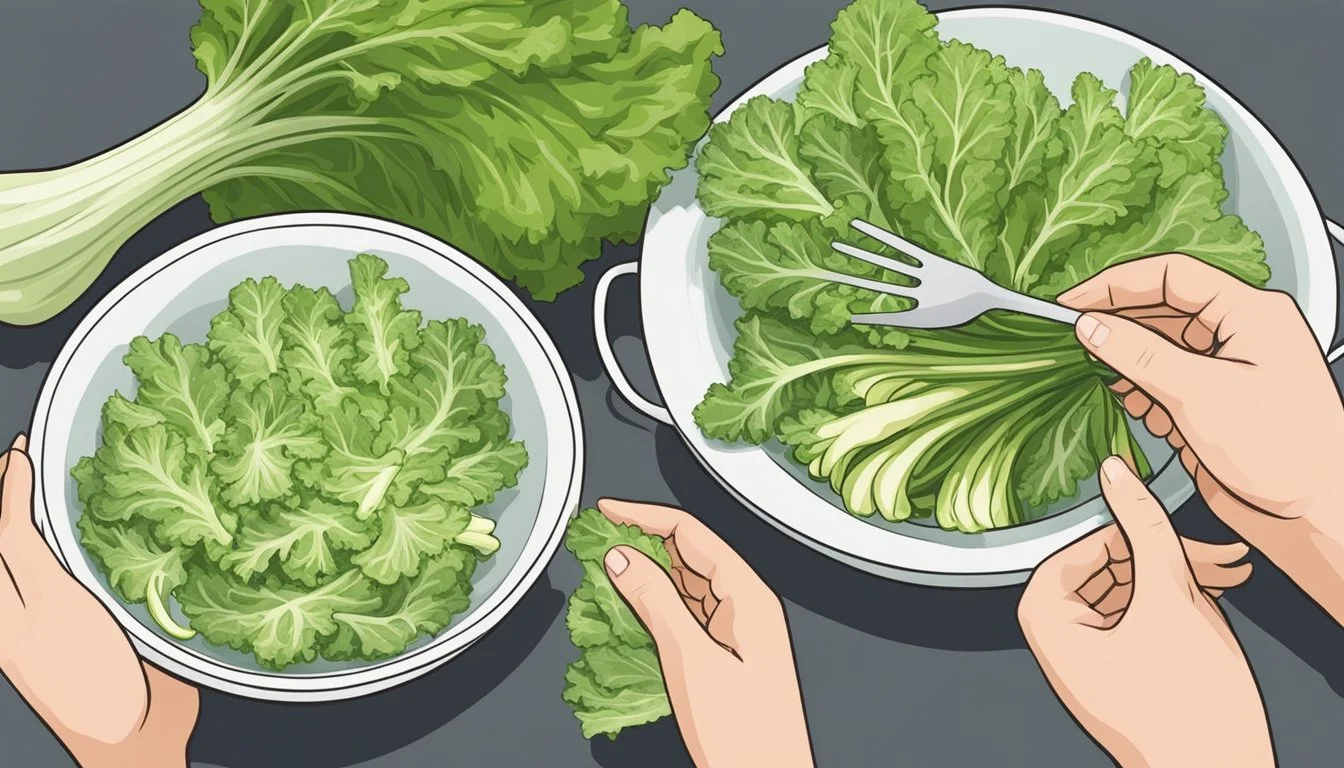How to Substitute Escarole for Curly Endive in Recipes
A Simple Switch
Escarole, a leafy green vegetable belonging to the chicory family, brings a pleasantly bitter flavor to a variety of dishes. Known for its broad, green leaves and slightly bitter taste, it serves as a nutritious addition to salads, soups, and sautés. With its versatility in the kitchen, it is sometimes necessary to find a suitable substitute due to availability or preference. Curly endive, often confused with escarole due to their similar appearance and taste profile, emerges as an excellent replacement that can seamlessly adapt to recipes calling for escarole.
Curly endive, also a member of the chicory family, shares a bitterness with escarole but has a frillier texture. This attribute makes it a preferred option in raw preparations such as salads, where its texture can mimic the lighter inner leaves of escarole. When cooked, it wilts similarly to escarole, making it easy to interchange in recipes that require a hearty texture. Utilizing curly endive as an escarole substitute not only maintains the integrity of the dish but also infuses it with a similar nutritional richness, offering a wealth of vitamins and minerals essential for health.
Incorporating curly endive into recipes as a stand-in for escarole is straightforward. It requires no complex alterations to culinary practices or seasonal adjustments. Chefs and home cooks alike can feel confident in opting for curly endive, trusting it to impart the requisite bitter note and fulfilling texture desired in dishes traditionally made with escarole. Whether embracing the green's raw crunch in a salad or its softened presence in a warm dish, curly endive proves to be an uncomplicated and effective alternative.
Understanding Escarole
Escarole, a leafy green vegetable known for its robust flavor and versatility in the kitchen, is an excellent substitute for curly endive. Its unique characteristics and nutritional profile make it suitable for a range of culinary applications, while providing important dietary fiber, vitamins, and minerals.
Characteristics of Escarole
Escarole is a member of the Chicory family and is identifiable by its broad, flat leaves that are a deep green on the outside and become lighter towards the center. Unlike its relative, curly endive, escarole's leaves are less frilly and present a milder bitterness. This leafy green is perfect for those who prefer a subtler bitter taste in their dishes.
Nutritional Value
Nutritional Composition of Escarole (Per 100 grams):
Calories: 23 kcal
Dietary Fiber: 3.1 g
Vitamins: High in Vitamin A and K
Minerals: Contains calcium, potassium, and iron
Escarole offers a range of health benefits due to its high nutrient content. It is particularly noted for its dietary fiber, supporting digestion, and its abundance of vitamins and minerals, which contribute to overall health.
Culinary Uses
Escarole is quite versatile in the kitchen. It can be used fresh in salads, offering a less bitter option compared to curly endive. When cooked, it wilts down significantly and can be sautéed and added to soups or pasta dishes. Its ability to retain texture when cooked makes it a popular choice for both hot and cold culinary preparations.
Salads: Incorporates well with other vegetables, providing texture and a slight bitterness.
Soups and Pasta: Holds up well in broth and adds depth to hearty and rustic dishes.
Cooking Methods: Can be sautéed with garlic and oil, steamed to reduce bitterness, or used as a base for stews.
Choosing Substitutes for Escarole
When selecting a substitute for escarole, it's crucial to consider how the alternative's taste and texture will complement the original recipe. The right substitute should evoke a similar flavor profile and maintain the integrity of the dish's texture.
Factors to Consider
Taste: Escarole has a mildly bitter flavor, more pronounced in its outer leaves than the inner ones. Substitutes should ideally offer a balance of bitterness to match escarole's unique taste.
Texture: The texture of escarole ranges from tender inner leaves to more robust outer leaves. A suitable replacement should offer a similar dichotomy or adjust cooking times to achieve a comparable texture.
Recipe context: Consider the role of escarole in the recipe—whether it's a raw application, such as salads, or a cooked dish like soups and sautés. This influences the choice of substitute, as some greens react differently to heat.
Popular Substitutes
The following table outlines substitutes for escarole based on the discussed factors:
Substitute Taste Texture Best Used In Chicory Bitter, closer to outer leaves Firm Cooked dishes Radicchio Slightly bitter, with a hint of spice Crunchy Salads, Pizzas Arugula Peppery flavor Tender Raw applications Broad-leaved Endive Gently bitter Crisp Salads, Sautés Spinach Mild sweetness Silky Soups, Casseroles Kale Earthy, slightly bitter Sturdy Braises, Stews Swiss Chard Mildly bitter Soft, yet robust Soups, Sautéing Mustard Greens Pungent, peppery taste Toothsome Raw or Cooked Collard Greens Bitter flavor Thick Simmered dishes Frisee Mild bitterness Frilly Fresh Salads Romaine Lettuce Crisp, mild flavor Crunchy Salads, Wraps
For instance, for raw preparations such as salads, choosing greens like radicchio or frisee can provide a similar crunch and bitterness. When cooking, one might opt for Swiss chard or kale to mirror the sturdiness and slight bitterness of escarole's outer leaves. Each substitute brings a unique dimension to the plate, but with mindful selection, they can serve as excellent stand-ins for escarole.
Substitutes for Specific Dishes
When substituting escarole for curly endive, cooks need to consider the dish's preparation method to ensure complementary flavors and textures are maintained. The following guidance provides targeted advice for different types of dishes.
Salads and Raw Preparations
For salads or dishes where escarole is served raw, curly endive seamlessly fits in due to its similar texture and slight bitterness. It can be used leaf for leaf in recipes. A classic vinaigrette with garlic, olive oil, and lemon is well-suited for curly endive's robust character.
Example Salad Recipe:
Ingredients: Curly endive leaves, sliced radishes, cherry tomatoes
Dressing: Olive oil, lemon juice, salt, black pepper
Cooked Dishes
In recipes where escarole is cooked, such as in stir-fries, stews, or sautéed as a side dish, the curly endive's slightly tougher texture requires a brief additional cooking time. Sauteing with olive oil and garlic brings out its flavor, making it a perfect stand-in.
Example for Stir-fries and Stews:
Ingredients: Substitute curly endive for escarole
Technique: Sauté curly endive for an extra 1-2 minutes or until desired tenderness is reached
Side Dishes
Curly endive can be wilted down with garlic and olive oil for a simple, flavorful side dish. Its bitter notes complement rich, fattier main dishes well and can be finished with a splash of lemon juice to balance the bitterness.
Example Side Dish:
Ingredients: Curly endive, minced garlic, olive oil, lemon juice
Technique: Cook on medium heat until the endive is wilted and infused with garlic flavor
How to Prepare and Cook Substitutes
When substituting escarole with curly endive, it is important to recognize that curly endive offers a less bitter taste, making it a versatile ingredient for salads and various cooking methods. This section provides guidance on preparation for raw ingredients in salads as well as cooking techniques best suited for curly endive.
Preparing for Salads
Curly endive can be used as a direct replacement for escarole in salads. To prepare, they should thoroughly wash the leaves to remove any dirt or grit. After washing, the leaves should be dried using a salad spinner or patting them down gently with a clean cloth or paper towel. It’s best to tear the leaves by hand into bite-sized pieces, as cutting with a knife can sometimes cause browning on the edges.
Step 1: Wash the leaves thoroughly.
Step 2: Dry the leaves completely.
Step 3: Tear the leaves into suitable sizes for inclusion in salads.
Cooking Techniques for Substitutes
Curly endive can be cooked using several techniques. Its slightly bitter taste becomes milder when cooked, making it a nutritious addition to warm dishes.
Sautéing: Heat a pan over medium heat, add a small amount of oil, and cook the curly endive until it wilts. This usually takes a few minutes. One can add garlic or other seasonings as desired for flavor.
Blanching: Blanched curly endive can be a great addition to dishes needing a less bitter green. To do this, one should boil the leaves briefly in salted water, then transfer them to an ice bath to stop the cooking process.
Baking or Grilling: For a different approach, curly endive can be baked or grilled. To bake, one should place the leaves on a baking sheet, drizzle with oil, and roast them until crispy. For grilling, they should place the leaves directly on the grill and cook them until they achieve a nice char.
For Sautéing:
Preheat a pan with oil.
Cook until wilted, add flavorings as needed.
For Blanching:
Boil in salted water, then cool in an ice bath.
For Baking or Grilling:
Drizzle with oil and cook until the desired texture is achieved.
Enhancing Flavor and Nutrition
When substituting escarole for curly endive, balancing the flavor profile and nutritional content is crucial for creating a harmonious dish. Here, we will explore how to complement the characteristic taste of curly endive and make the most out of this substitute.
Pairings and Combinations
Curly endive, with its bold, peppery flavor, can be slightly more intense than the milder escarole. To counterbalance this, incorporating complementary flavors and ingredients is key. Bold ingredients like bacon and avocado pair exceptionally well, as their rich textures and tastes offset the endive's pepperiness. For a touch of sweetness and texture contrast, consider adding pear slices or chopped walnuts. These are not only flavorful but also enhance the dish's nutritional value with added vitamins, healthy fats, and fiber. For those enjoying a vegetarian option, roasting carrots and ginger can bring out a natural sweetness that complements the curly endive's assertiveness.
Flavor Pairings:
Rich: Bacon, Avocado
Sweet: Pears, Carrots
Crunchy: Walnuts
Zesty: Ginger
Making the Most of Your Substitute
While curly endive can stand in for escarole, adjusting the preparation to suit the substitute’s peppery taste is essential. Curly endive may benefit from a quick sauté or steam to reduce its peppery impact, giving it a milder flavor akin to escarole. One might choose to sauté with cream to add a luxurious texture and to further tame the bitterness of the endive. Alternatively, using the endive raw in salads maximizes its crisp texture and nutrition while a quick blanch can soften its peppery notes for those who prefer a gentler flavor.
Preparation Techniques:
Cooked: Sauté with cream
Raw: Crisp salads
Blanched: To soften flavor
Integrating Substitutes into Diets
When considering dietary substitutions, it is essential to understand how to integrate alternatives like curly endive into various cuisines. Factoring in taste, texture, and cooking methods, one can successfully use this leafy green as a stand-in for escarole.
For Mediterranean Cuisine
In Mediterranean and specifically Italian cuisine, escarole is a common ingredient found in dishes like Italian Wedding Soup and green salads. Substituting escarole with curly endive in these recipes is seamless due to their similar bitterness and leafy textures. Here is how to incorporate curly endive:
Italian Wedding Soup: Use curly endive in a 1:1 ratio for escarole. Its robust nature holds up well, creating a similar mouthfeel.
Green Salad: For a broad-leaf Mediterranean salad, curly endive offers a comparable crispness. Toss it with other Mediterranean staples like olives, feta, and a lemon-olive oil dressing.
In Asian Dishes
While escarole may not be widely used in Asian cuisine, integrating curly endive can introduce a new dimension to familiar dishes. Here’s how it can be adapted:
Korean Dishes: Curly endive can be added to Korean side dishes, such as banchan, contributing a refreshing crunch. It can also be lightly pickled with a Korean-style vinaigrette.
Chinese Cuisine: In Chinese stir-fries or soups, curly endive's resilience to heat makes it a suitable alternative. Its slightly bitter flavor complements bold spices and sauces, adding depth to dishes like hot and sour soup or sautéed leafy greens with garlic.
Each culinary tradition has its own characteristics, but curly endive's adaptability makes it an excellent substitute for escarole, enriching a variety of dishes with its versatility.
Final Considerations
When substituting escarole for curly endive, one must not only consider the taste and texture compatibility but also how the switch may affect the nutritional profile of the dish. These final considerations ensure that one achieves a seamless transition without compromising the overall healthiness of the meal.
Maintaining a Balanced Diet
Escarole and curly endive are leafy greens that contribute to a balanced diet by offering a range of essential nutrients. They are both excellent sources of antioxidants, vitamin A, vitamin C, and iron, which collectively support immune function, vision, and skin health. It is also important to note that they provide a decent quantity of calcium, beneficial for bone health. When substituting, ensure the switch does not dramatically alter the nutritional value your body expects to receive.
Antioxidants: Crucial for combating oxidative stress.
Calcium & Vitamin A: Support bone health and vision.
Vitamin C: Essential for immune defense and collagen production.
Iron: Key for blood production and oxygen transport.
Further Tips on Substitution
One should approach the substitution process with a few key strategies in mind. The goal is to retain the dish's intended flavor and nutritional benefits.
Texture Similarity: Curly endive can mimic the slightly crunchy texture of escarole.
Flavor Match: Although curly endive may have a sharper bitter edge, it closely resembles the milder bitterness of escarole.
Upon substituting, one may adjust quantities slightly if the endive's flavor seems too pronounced or if its texture varies significantly from that of escarole. Always taste as you go and adjust seasonings accordingly to maintain the desired flavor profile.








